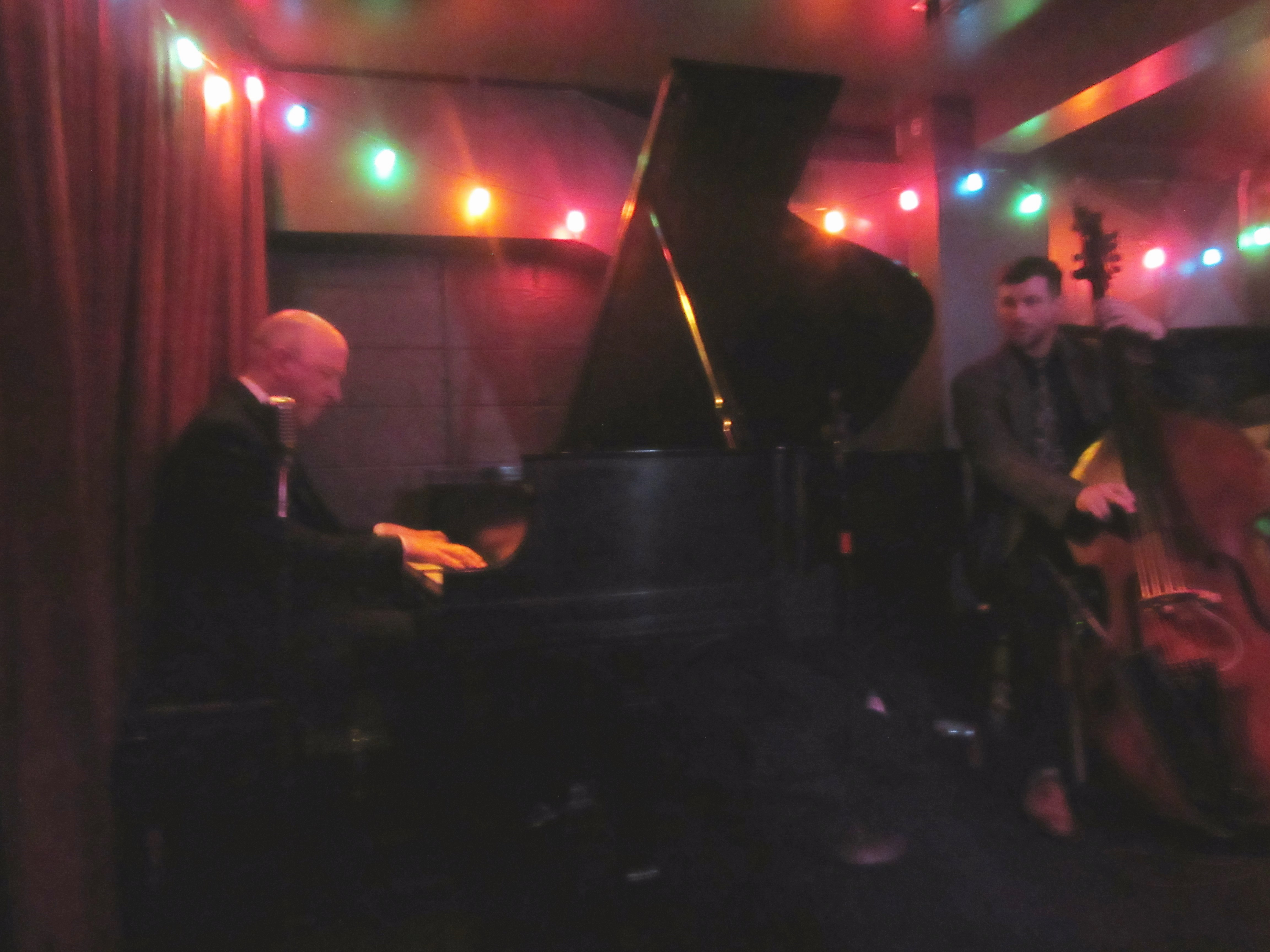
Pianist Rick Germanson and bassist Peter Dominguez perform Dec. 23rd at the The Jazz Estate in Milwaukee (Photos taken by Kevin Lynch, unless otherwise indicated, in a low light without flash.)
T’wasn’t the night before Christmas, but all through the club all the creatures were swinging, even the mouse. Actually it was two nights before the magical, mystical night in a Bethlehem manger.
The band did play one seasonal song, Mel Torme’s “The Christmas Song” — as if they’d just dreamed it up in a sugarplum fever. Yet pianist Rick Germanson so deftly veiled it in fresh voicings that it spurred a debate between me and my girlfriend on the song title (I won).
“Merry Christmas, everyone,” the pianist said at the song’s end.
But these three men were home for the holidays. And by that time, in the second set, they’d delivered arms full of gifts, like three wise men from the Orient, casting riches upon our little jazz scene — compared to New York, as humble as the hay-strewn Bethlehem manger.
Sure enough they were all coming far from The East. New York, that is – not “the Orient” (which still exists only as a dated cultural construct).
All the rest of it was quite serious music-making, or I should say serious fun, because it mainly grew out of the loamy soil of hard-bop, which takes the most salient and vibrant aspects of bebop and he gives them a palpably funky and bluesy boost.
Or to mix a merry metaphor, it tasted like eggnog spiked liberally with something that never made Milwaukee famous – modern jazz, on December 23rd at the newly renovated and reopened Jazz Estate on Milwaukee’s East side.
The New York-based Rick Germanson Trio, all Milwaukee-area natives, made their hometown proud, and even gave this veteran jazz observer jolts of surprise, delight and, at times, mystification, as in: How the hell does he do that?
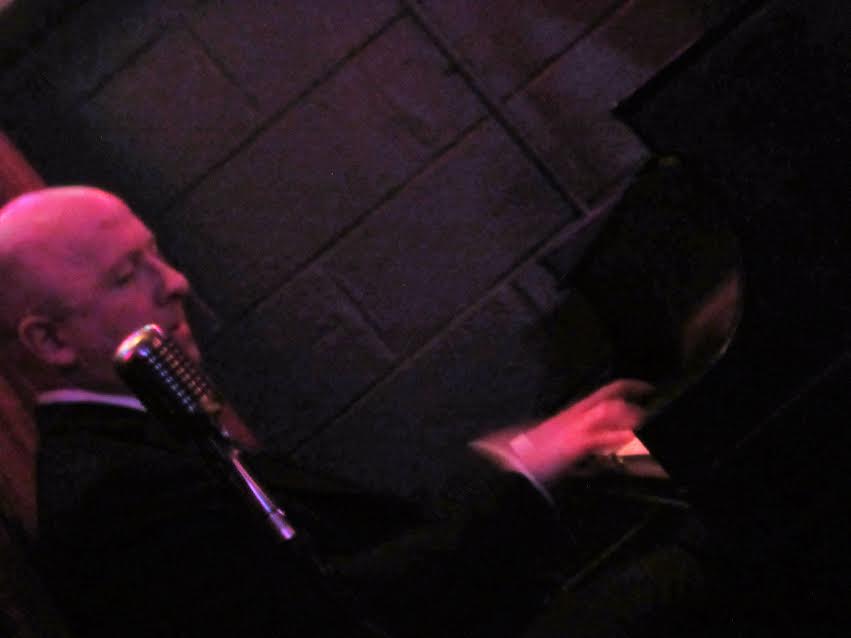
Rick Germanson takes a solo.
I figured that Germanson and his mates would be pretty damn good. But this was nearly off the jazz charts that none of these guys needed. In fact, the pianist, whom I observed closely with a virtual keyboard-side seat, repeatedly played extremely complicated and dynamic passages with intense concentration. Yet his eyes fixed somewhere far beyond the keyboard. That “look-ma-no-look!” effect just hints at the man’s mastery.
“In New York, Rick’s nickname is ‘Brick,'” said his bassist Peter Dominguez after the gig, flexing his right arm into a curl for emphasis, “because he’s so strong! And he takes no prisoners. Either you’re ready for him, or not.”
Consider that New York is, by far, the toughest and most competitive jazz scene in the world, and you begin to sense the mark with Germanson is making far beyond old Brewtown.
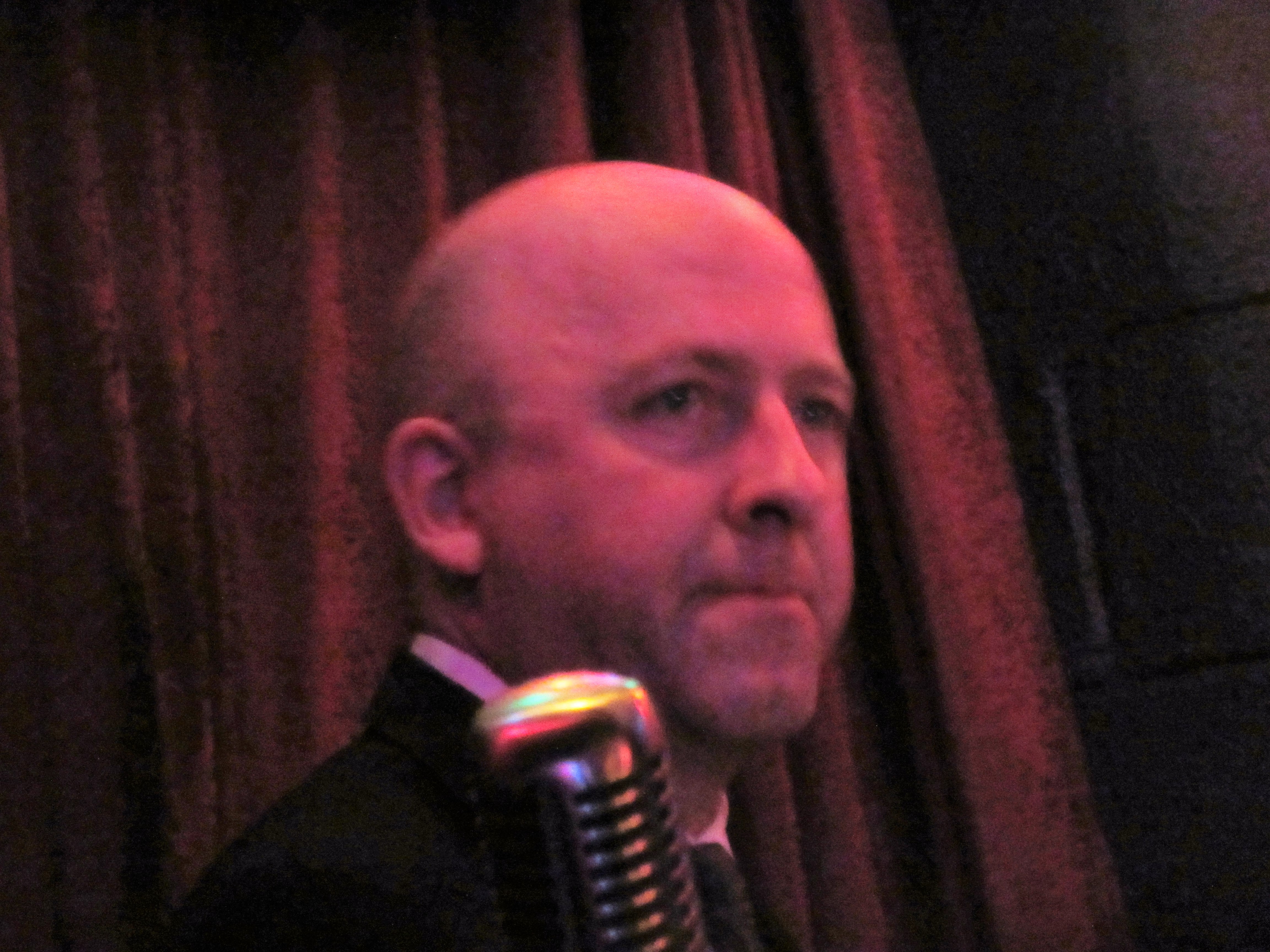
On his Jazz Estate gig, Milwaukee native Rick Germanson displayed the musical determination to succeed as a jazz artist, which has earned him the nickname “The Brick” in New York, where he now lives. Photo by Ann K. Peterson.
Yet, he still seems under the national radar, despite his New York bona fides, including extended stints with guitarist Pat Martino and the Cannonball Adderley Legacy Band featuring Louis Hayes, and work with The Elvin Jones Jazz Machine, Mingus Dynasty, Tom Harrell, Jeremy Pelt, Brian Lynch among others, and co-leading his last recording with trumpeter Eddie Henderson.
Germanson was nowhere to be found in the latest Down Beat International Critics Poll, which I have contributed to in the past. After listening to his too-few recordings as a leader and on this stunning night, I would place him in the top 10 pianists, perhaps even number seven, right behind Brad Mehldau. And noting the unsurprising poll-winner Kenny Barron, it struck me why Germanson’s dark-horse presence is so well-earned. His overall style compares with Barron’s. Perhaps the elder pianist possesses unsurpassed elegance, offhanded ease and range of repertoire. But Germanson, at 44, is right in his prime, and can do most anything Barron can do, it seems.
(Full disclosure: about 17 years ago, Germanson played solo piano at my second wedding’s reception in Madison. But it was an accident of circumstance, as my chosen pianist, Dave Stoler, needed a last-minute substitute. I had little chance to really hear Germanson play that busy day.)
Some close-listening critics might argue that his influences remain a bit too evident. They’re detectable but also myriad. Just sitting through a few tunes, I scribbled down the relevant names: Ahmad Jamal, Cedar Walton, Ramsey Lewis, Bill Evans, Herbie Hancock, Bobby Timmons, Hank Jones, McCoy Tyner. But Germanson tosses off these aspects with such alacrity that they ultimately feel integrated into an astonishingly wide mainstream jazz piano vocabulary. Call the dialect “post-hard-bop Germanson.”
There was Evans’ pensive ballad “Very Early,” with his sinuously-kneaded chord changes, and then Bobby Timmons’ groove-twitching “Jive Samba,” a tune Germanson surely played countless times with the Adderley Legacy Band.
Then yet another stylistic shift to the modern Coltrane-esque modalism of Cedar Walton’s “Holy Land,” wherein he carries you to the Promised Land with powerful gusts of crystalline sand and whirling wind. You can imagine how brilliantly he embraced the McCoy Tyner-esque stylistic power strokes Elvin Jones was accustomed to in his rhythmic cauldrons.
Yet, at times, I wish he’d be a bit more harmonically daring and bullish, dash one flat or second interval hard across the grain, like Monk might. But Rick’s fully sophisticated in the post-bop tradition, so that caveat only seemed like a late-set afterthought. In re-voicing familiar tunes like “Autumn in New York” or “Surrey with the Fringe on Top,” he lulls you with a theme-in-the-breeze, like a siren on the shore, rather than simply stating it. That way, he pulls you into his orbit and, with his encyclopedic stylistic resources, you feel set for a long stay.
The strategic success, at least of this live set, took off from a hard-bop pad. So the band often plays like a canny, old-time carnival clown – plenty of deep pockets full of surprises and loads of nimble wit to spur bobbing heads and chuckles of amazed delight. And in a place as intimate as The Jazz Estate, virtually the whole audience palpably feels it all down to their tapping toes. And if there’s a mouse or two lurking (unlikely), they’re surely hipsters, too. 1
At the heart of any great straight-ahead jazz style, as with Germanson, is the creative space facilitated by continual dynamic accents and deep-in-the-groove currents. Here too, he shines, his playing bejeweled with tough rhythmic finger drumming, incredibly tight sustained octave tremolos, or cross-punching tiger-paw attacks, or long, crackling-swift arpeggios.
And yet Germanson seems to know when to pull his own reins in and not seem like a show horse. He often offers such a gambit as a discrete jewel setting, with crisp entrances and segues. He almost floats against a pulsing flow of bassist Peter Dominguez and drummer Pete Zimmer. These two possess the power, precision and elasticity of a great neo-bop rhythm section, such as the 1980s Heath Brothers Band with its bounding harmonies and hop-skip-skittering rhythms. (continue reading below)
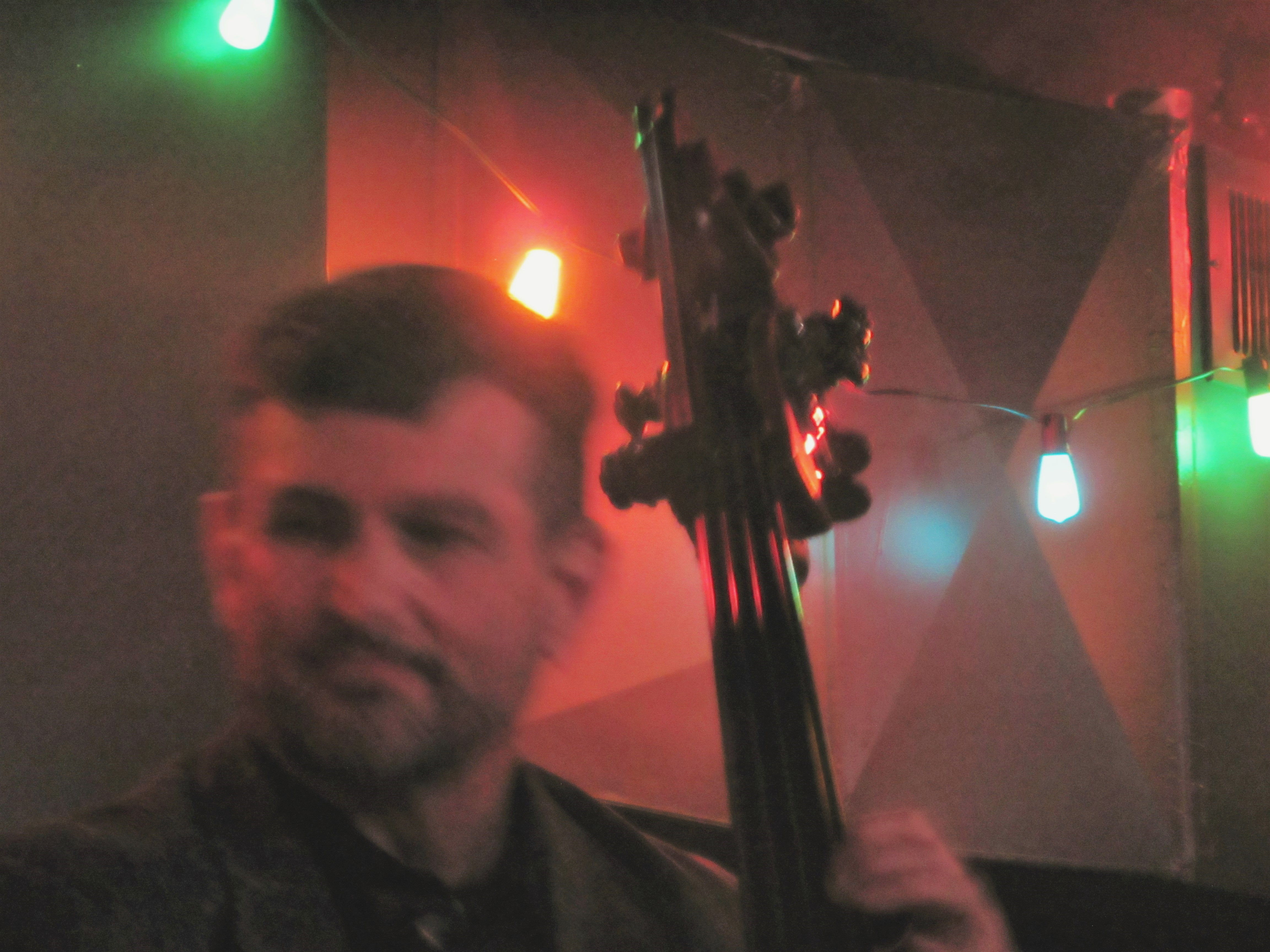
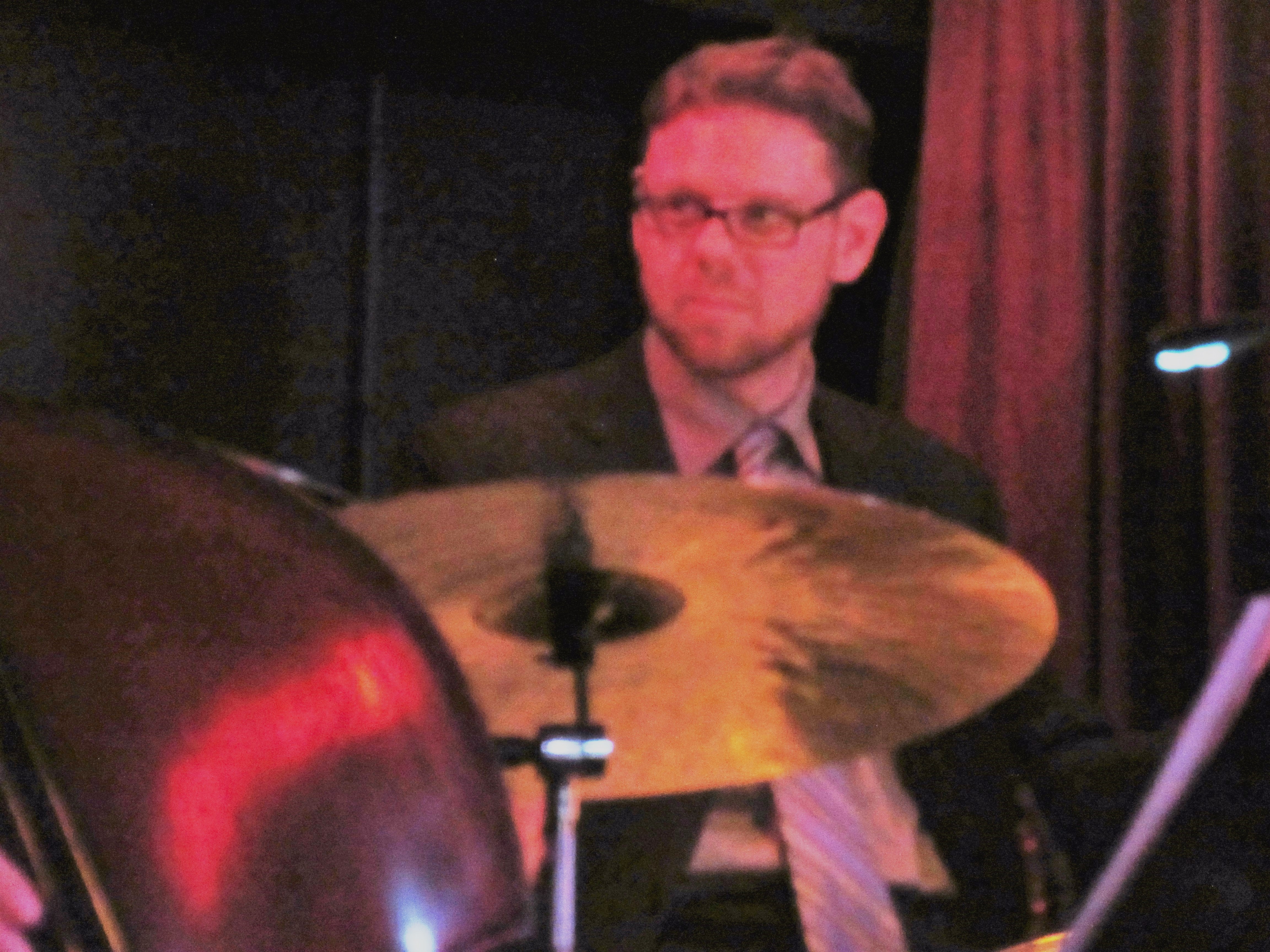
Bassist Peter Dominguez (above) and drummer Pete Zimmer playing with Rick Germanson at the Jazz Estate.
The second set helped affirm the pianist-composer’s evolving originality, as in “Rick’s Blues,” in which to Dominguez displayed his arco chops on a solo with fine, deeply resonating legato and highly evocative effect. This reveals his study with the great Madison bassist Richard Davis, one of the supreme masters of jazz bass bowing. (Germanson and Dominguez also display superb simpatico, taste and imagination on the Dominguez album How About This, a trio recording with former Herbie Hancock drummer Billy Hart.)
“Daytona” took a muscular McCoy Tyner approach and gives it a Latin twist. Even more distinctive was Germanson’s “Theme for Elliott,” written for his son, which “kind of captures his vibe,” he offered. A deceptively simple one-handed melody, like a boy might pick out on a keyboard, develops into a thoughtful but slightly impetuous exposition, tempered by recesses of shyness, a lyrical but probing creation.
Another personal gesture arose in “Susan’s Waltz,” written for his wife, who stood approvingly a few feet away from the keyboard. It seems almost a gently-traced character sketch, folded between deft chords. Here bassist Dominguez remade the melody like a grizzly bear capturing a butterfly in his paw, and slowly and tenderly letting it fly away.
The trio upped the power quotient in the Tyner mode on Germanson’s “Interloper,” conveying an apt sense of intrigue and drama. The three men from the East absolutely burned through this, with the sort of spiritual power akin to Tyner in his prime. Drummer Zimmer bristled with a swift-yet-sharp tempo and bassist Dominguez unleashed a panther-swift fast-walking pulse. Germanson’s solo set off fireworks, riding a powerful left-hand thunder of chords. And yet his ruthlessly rapid right hand didn’t really mimic Tyner, nobody quite can. Plus, his solo delved into complex harmonic underpinnings reminiscent of Herbie Hancock’s impressionistic sorties.
It all ended with a brief encore rendering of Miles Davis’s set-closing standard, “The Theme,” which I hardly recognized with the re-harmonizing that Germanson says he drew from the late Cedar Walton’s approach to it.
Yes, Walton is one of this pianist’s touchstone fathers. But Rick “The Brick” has found himself, proving an old adage, that finally the child is the father to the man, his own man.
____________
1. A few more words about the new-and-improved Jazz Estate. It was a great listening space to begin with, but an excellent move was to re-configure the small back room. Instead of a cluster of tiny tables and chairs, the new owner built connected booth seating along the two walls leading to the back exit. This allows for at least several extra seats, and more lounging comfort through the last set. And the restrooms, previously merely functional, like many jazz clubs, now have “expanded fixtures” and very classy furnishings.

